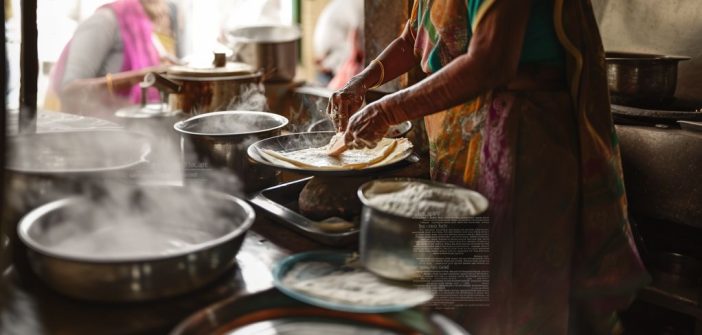Welcome, wonderful readers, today, we’re diving into the delightful world of appam, a beloved pancake-like dish from South India and Sri Lanka. Known for its lacy, crisp edges and soft, fluffy center, appam ?? is made from a fermented batter of rice and coconut milk, giving it a unique taste and texture. Naturally gluten-free and vegan, appam is traditionally cooked in a special pan to achieve its distinctive bowl shape. With roots tracing back to ancient Tamil literature, this versatile dish can be enjoyed both sweet and savory.
In earlier articles, we’ve savored an array of tantalizing recipes, ranging from the aromatic Islamic Biryani ? to the revitalizing post-yoga energy shots, conveniently found towards the conclusion of this blog. Prepare yourself for a delectable exploration into the enchanting universe of Appam ??.
Please follow the link to the recipe ➡️:
https://youtube.com/shorts/CrksKbr_coI?feature=share
Where Does Appam Come From? ?

Appam, a cherished rice pancake, originates from the culinary traditions of South India and Sri Lanka. Its precise origins are debated, but ancient Tamil literature from the 5th century n. Chr. mentions appam, suggesting deep roots in Tamil Nadu, Madurai. The word “appam” is derived from the Sanskrit “apupa,” meaning “rice cake,” highlighting its ancient heritage.
In Kerala, appam’s history is intertwined with the Jewish community, who likely introduced the use of toddy for fermentation, leading to the distinctive palappam. This blend of rice and coconut milk, fermented to perfection, has become a staple in Kerala’s cuisine.
The dish also traveled to Sri Lanka, where it is known as “hopper”, “அப்பம்” (Appam) showcasing a shared culinary heritage. Despite theories of Dutch influence, most evidence points to appam being a time-honored dish in South India long before European colonization. Its story is a fascinating blend of Tamil, Jewish, and Sri Lankan influences, making appam a true culinary legend.
The Kurma Avatar: Vishnu’s Divine Tortoise Tale ?✨

In Tamil culture, the appam holds a special significance beyond its culinary delight. Its distinctive bowl-shape is believed to be inspired by Lord Vishnu’s Kurma (tortoise) avatar from Hindu mythology, representing a fusion of culinary tradition and spiritual symbolism. As we delve into the captivating tale of Kurma Avatar, we uncover the profound connection between this divine narrative and the beloved South Indian delicacy.
The Mythological Marvel ?
In Hindu mythology, Lord Vishnu is revered for his numerous avatars, or incarnations, which he assumes to maintain cosmic balance and combat malevolent forces. Among these avatars is Kurma, where Vishnu takes the form of a tortoise. This avatar holds profound spiritual significance and teaches invaluable lessons about resilience and selflessness.
According to Hindu scriptures, Kurma is Vishnu’s second avatar. The word “Kurma” translates to “turtle” in Sanskrit. Legend has it that Vishnu assumed this form to assist the Devas (celestial beings) and Asuras (demons) in churning the ocean of milk (Samudra Manthan) to retrieve the nectar of immortality (Amrita).
The Devas and Asuras collaborated to churn the ocean, aiming to obtain the Amrita and end their eternal conflict. Mount Mandara was chosen as the churning rod, but it required support to prevent it from sinking. Vishnu, in his Kurma Avatar, became the pivot by balancing the mountain on his back, ensuring stability and equilibrium during the process.
As the churning commenced, various celestial treasures emerged from the ocean, including the wish-fulfilling tree Kalpavriksha and the divine cow Kamadhenu. Ultimately, Dhanvantari, the physician of the gods, emerged carrying the pot of Amrita. Vishnu ensured that the nectar was distributed among the Devas, restoring their vitality and tipping the balance of power in their favour.
Symbolism and Significance ?
The Kurma Avatar is rich in symbolism. The tortoise, known for its patience and resilience, represents detachment from material concerns. Vishnu’s choice of this form highlights the importance of staying calm and steadfast in the face of challenges, teaching us valuable lessons in patience and perseverance.
Lessons from Kurma Avatar ?
The story of the Kurma Avatar is brimming with lessons. It underscores humility, as even the mighty Vishnu took a humble form to serve a greater purpose. It teaches selflessness and sacrifice, demonstrating Vishnu’s willingness to bear the weight of the world for the benefit of others.
Temples and Celebrations ?
While not as widely worshipped as other avatars, Kurma has dedicated temples, such as the ancient Kurmanathaswamy Temple in Tamil Nadu, India. Thousands flock to this temple, especially during the Kurma Jayanti festival, seeking blessings of patience, perseverance, and spiritual enlightenment.
Surprising Benefits of Appam Revealed
Appam is packed with potential health benefits that might surprise you. Let’s delve into how this South Indian delicacy can contribute to your overall well-being:
Weight Management ?️
The fiber content in appam can keep you feeling full for longer periods, curbing those midday snack cravings and potentially aiding in weight management. However, remember that moderation is key, as excessive consumption can still lead to unwanted calorie intake.
Vegan-Friendly Delight ?
For those following a plant-based diet, appam is a perfect choice. It’s crafted without any dairy products, making it a delightful option for vegans looking for a scrumptious meal.
Gluten-Free Goodness ?
Say goodbye to gluten concerns! Appam’s primary ingredients – rice and coconut milk – make it naturally gluten-free. So, if you’re dealing with celiac disease or gluten intolerance, you can indulge in appam without any worries.
Probiotic Powerhouse ?
Thanks to the fermentation process involved in making appam batter, it can introduce beneficial probiotics to your gut. These friendly bacteria can work wonders for your digestion and overall gut health, promoting a happier tummy.
Cholesterol Champion ?
If you’re watching your cholesterol levels, appam is a stellar choice. It contains zero cholesterol, as it’s crafted from wholesome plant-based ingredients like rice and coconut milk.
So, next time you savor a plate of appam, know that you’re not just treating your taste buds – you’re also nourishing your body with a plethora of potential health benefits!
Appam Recipe ??
Follow along with my video on how to make Appam!
??? Cook Time: 40 min |⏳ Waiting Time: 14h | ⏱️ Total Time: 880 min |? Servings: 3-4 Servings
? Ingredients:
- 150 g white long-grain
- 100 ml coconut water
- Halve a coconut
- 7 g yeast
- Salt and brown sugar
For Chutney:
- 1 onion
- 2 dry red chili
- Salt, lemon juice
? Instructions:
- Wash the white long-grain rice ? thoroughly, repeating the process 2-3 times.
- Soak the white long-grain rice in water for approximately 6 hours.
- After soaking, rinse the rice ? again and drain all the water.
- Transfer the soaked rice to a grinder and grind until a fine powder forms.
- Take two tablespoons ? of the powdered rice and mix it with 20ml water to form a solid paste.
- Stir the paste in a pan over low heat until it thickens into a solid paste.
- In another pan, combine the remaining powdered rice, yeast, coconut water, and the solid paste mixture. Mix well until a milky dough forms.
- Let the dough sit for 8 hours ? or overnight.
- When ready to fry the appams, cut the coconut in half ?✂️ and grind it with 200ml water to make grated coconut puree.
- Rinse the coconut puree and collect the coconut milk in a bowl.
- Add the coconut milk ?, salt, and brown sugar to the appam dough. Stir well to combine.
- Your appam dough is now ready to make appams ??.
- Heat a small pan and pour a ladleful of the appam batter into the pan.
- Swirl the pan to spread the batter into a round shape ?, covering the entire surface.
- Cover the pan with a lid and cook the appam for 5 minutes or until the edges turn golden brown.
- Your appam is now ready to be enjoyed ?!
P.S: To store the appams longer, you can keep them in the refrigerator only for one day not any longer!

Thank you for embarking on this savory journey with me!
Delighting in your first taste of those golden-brown appams ?? Close your eyes, immerse yourself in the harmonious blend of spices and textures, and savor the tale woven into every mouthful.
I’m certain you’ll find these appams as delightful as I do. Share your impressions by dropping a comment below. ? Did they wrap you in warmth and contentment? ? Let’s revel in this culinary escapade together!
Catch up on my other posts!
- Dive into a week of Kola Kenda? and unlock its healing magic – I’m eager to read about your experiences!
- And if you’re intrigued for more tantalizing Tamil recipes and curious about their rich heritage, don’t miss my video guide to aromatic islamic Biryani ?
- A blog post on ABC-shots for that post-yoga power boost! ??♀️
- I also made a blog post on Unboxing: 7 Karma Convenience Vegetarian Products ?
- For the Cheese Lovers: Elevate Your Curry Game with Paneer?
- Protien Snacks: A Guide to Vegan Snacks for Every Occasion ?
- Nathan Kadai Review ?️: Your Physical One-Stop Shop for Indian & Sri Lankan Groceries
Bibliography:
- George, S. (2022, May 2). Who needs easter eggs when you can have appams? — Whetstone Magazine. Whetstone Magazine. https://www.whetstonemagazine.com/south-asia-journal/who-needs-easter-eggs-when-you-can-have-appams
- MythologyWorldwide. (2024, March 1). The Myth of Kurma Avatar: The Tortoise Incarnation. https://mythologyworldwide.com/the-myth-of-kurma-avatar-the-tortoise-incarnation/
- What does APPAM mean? (n.d.). https://www.definitions.net/definition/APPAM
- Lau, R. (2018, March 1). APPAM: A delicious history. RICE. https://www.ricemedia.co/culture-food-appam-a-delicious-history/
- History of APPAM · Singapore Hawker Heritage. (n.d.). Tony Johor Kaki Travels for Food · Heritage · Culture · History. https://johorkaki.blogspot.com/2021/12/history-of-appam-singapore-hawker.html



